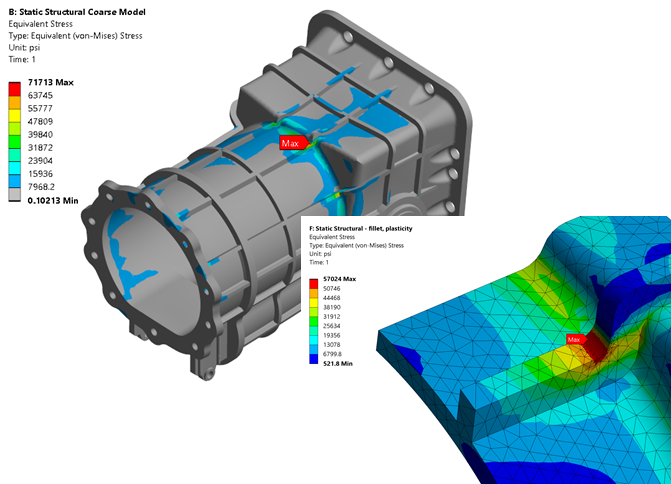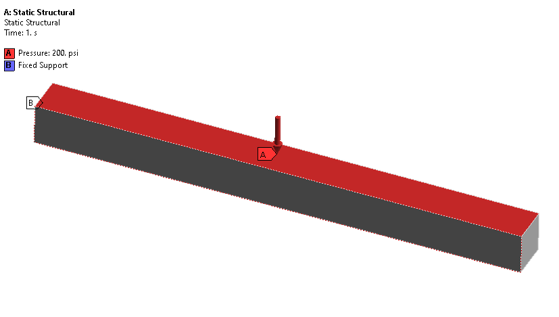
Ansys Mechanical Structural Dynamics
Ansys Mechanical Structural Dynamics
two-day courseThe objective of this course is for attendees to develop significant expertise in the use of Ansys Mechanical for dynamic analysis over a wide range of applications. The course emphasizes linear dynamic analysis, although it has one chapter and several workshops on nonlinear transient dynamic analysis. DRD collaborated with one of its customers, a large defense electronics firm, to develop important components of this course, and most of the workshops are practical examples based on problems that DRD has solved for its customers on a consulting basis or through Ansys technical support.
The course emphasizes good Ansys modeling practices and verification of correct solutions. DRD recommends using closed form equations based on solutions to single degree of freedom models to verify solutions to complex multiple degree of freedom models, and in this course students use hand calculations to check solutions to normal models, random vibration, response spectrum, and half sine shock models.
The course includes more than a dozen workshops in which the students use techniques covered in the course lectures to solve real-world problems. Some of the workshops have minimal instruction so that students can begin testing their skills under the supervision of an instructor during the course.
Prerequisites for this course are DRD’s Introduction to Mechanical course and some practical experience using Ansys Mechanical. This is a challenging course for proficient users.
Chapter 1 Normal Modes (Natural Frequency) Analysis
Workshop 1a Normal Modes Analysis of an Alternator Bracket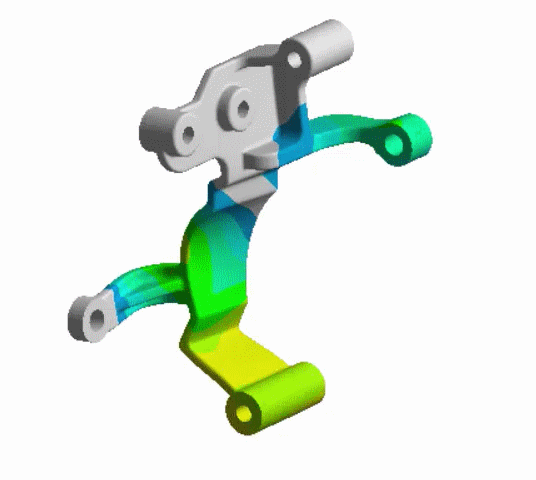
This bracket connects an alternator to a marine engine. The student learns to set up, solve and post process a normal modes model. The workshop involves representing the alternator as a point mass including mass moments of inertia. The student experiments with rigid and deformable connections of the point mass to the bracket attach locations. Students also learn the process of using a static solution to pre-stress the modal model and to evaluate the influence of the pre-stress on the normal mode frequencies and mode shapes.
Workshop 1b Normal Modes Analysis of a PWB Assembly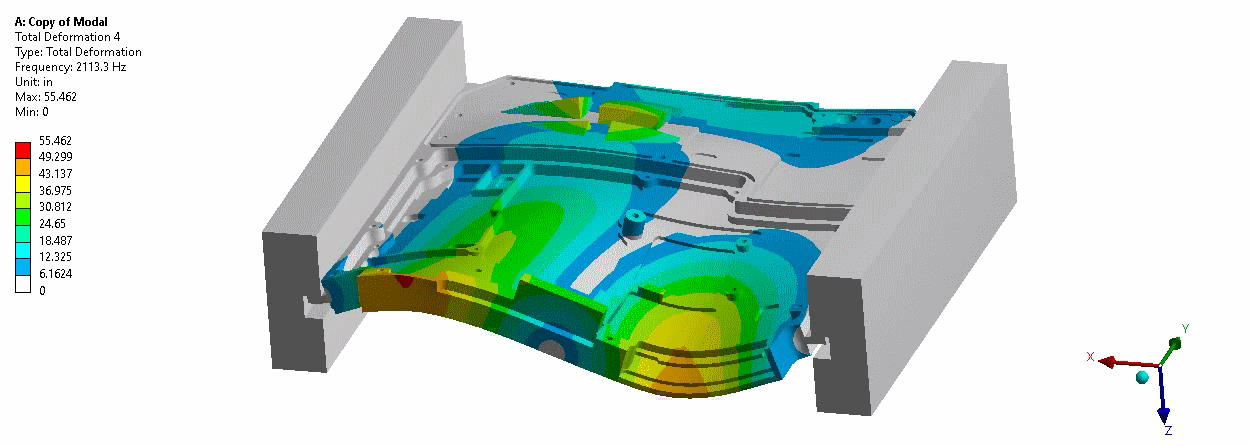
This PWB assembly is representative of electronics products that many Ansys customers qualify by putting on a shaker table. This workshop reinforces skills the student began to develop in Workshop 1a. The student also experiments with the direct and iterative solvers to determine which is faster. The workshop also guides the student on how to simplify the model to a single degree of freedom systems and to check the first natural frequency with a hand calculation based on the equation f = √(K/M), where f is natural frequency, K is stiffness, and M is mass.
Chapter 2 Random Vibration Analysis
Workshop 2 Random Vibration Analysis of a PWB Assembly
This workshop extends workshop 1b to include random vibration and fatigue life prediction for a 2 hour shaker table test. The student defines a random vibration PSD spectrum, solves the model, reviews standard deviation of stress (1s, 2s, and 3s) and finally evaluates fatigue life using the Steinberg method. Postprocessing also includes defining probes for response PSD and calculation of apparent frequency. The instructor will review the Steinberg calculations in a spreadsheet and confirm that the spreadsheet calculations match the Ansys results.
The workshop also shows the student how to approximate the 1s displacements with a hand calculation using the equation:
a = √ (Π/2 P fn Q)*
a = Acceleration in G
P = PSD value in G2/Hz from PSD curve at the natural frequency of the SDOF system
fn = Natural frequency of SDOF system, Hz
Q = Transmissibility of SDOF system = 1/2x**; where x is the damping ratio.
Chapter 3 Response Spectrum Analysis
Workshop 3a Response Spectrum Analysis of a Telecommunication Rack Subjected to Zone 4 Seismic Load (Telcordia Specifications)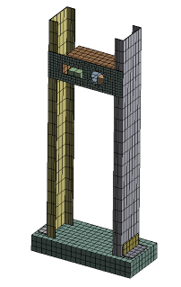
This workshop introduces the student to response spectrum analysis in Ansys. The student will first perform normal modes analysis on a telecommunications equipment rack and then define a Zone 4 response spectrum load. Zone 4 is accepted throughout the telecommunications industry as the most severe type of seismic loading, and many companies are required to pass a Zone 4 shaker table test in order to qualify their equipment. After performing the solution with the Zone 4 spectrum the student will review the maximum displacements and stresses due to the Zone 4 test.
The workshop also shows the student how to approximate the maximum rack displacements by approximating the model as a single degree of freedom spring-mass system.
Workshop 3b Response Spectrum Analysis of a PWB Assembly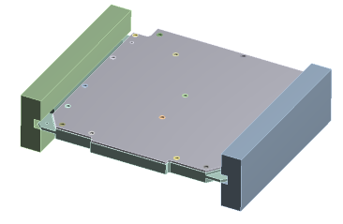

This work reinforces skills the student learned in Workshop 3a. In addition the workshop guides the student through the process of making sure he uses a sufficient number of modes in the normal modes analysis to get good answers in the response spectrum analysis.
Chapter 4 Full Transient Dynamic Analysis
Workshop 4 Full Transient Dynamic Analysis of a Black Box Electronics Assembly Subjected to a Half Sine Shock

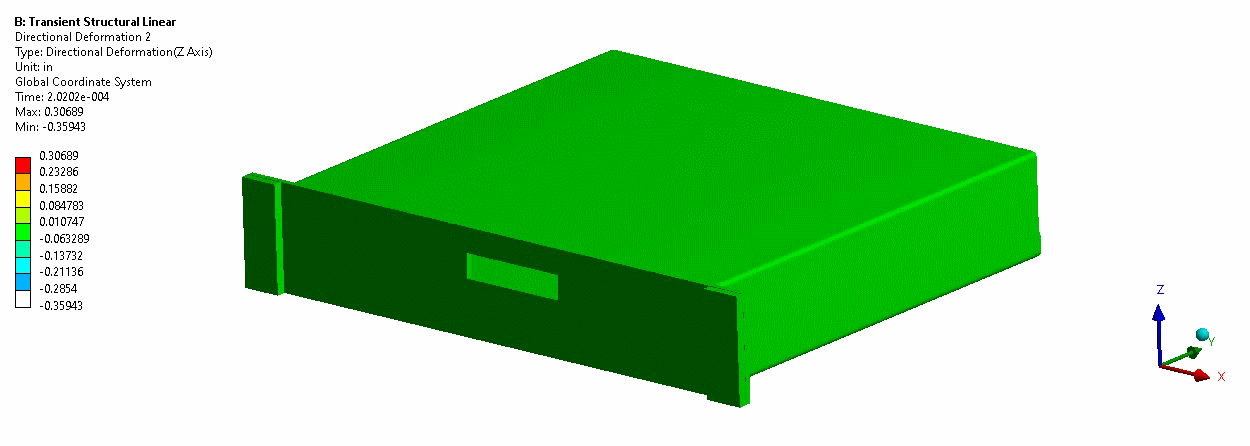 Many Ansys customers qualify their products by putting them on a shaker table and subjecting them to half sine shock. This workshop guides the student through a half sine shock analysis of a Black Box Electronics Assembly using the full transient Ansys solver.
Many Ansys customers qualify their products by putting them on a shaker table and subjecting them to half sine shock. This workshop guides the student through a half sine shock analysis of a Black Box Electronics Assembly using the full transient Ansys solver.
The student solves the model as linear and then solves it as nonlinear by activating large deflection effects. Finally the student compares solution times and results to weigh the trade offs in modeling the structure as linear and nonlinear.
Chapter 5 Mode Superposition Transient Analysis
Workshop 5a Mode Superposition Transient Analysis of a Black Box Electronics Assembly Subjected to a Half Sine Shock

In this workshop the student solves the model of workshop 4a using the mode superposition transient solver instead of the full transient solver.
The student acquires additional postprocessing skill related to transient analysis. He also solves the model using different numbers of modes to confirm that he has used a sufficient number of modes to get good transient results.
Workshop 5b Seismic Mode Superposition Transient and Response Spectrum Analysis of a Telecommunications Rack
 The student subjects the telecommunications rack from a previous workshop to seismic loads from the famous
The student subjects the telecommunications rack from a previous workshop to seismic loads from the famous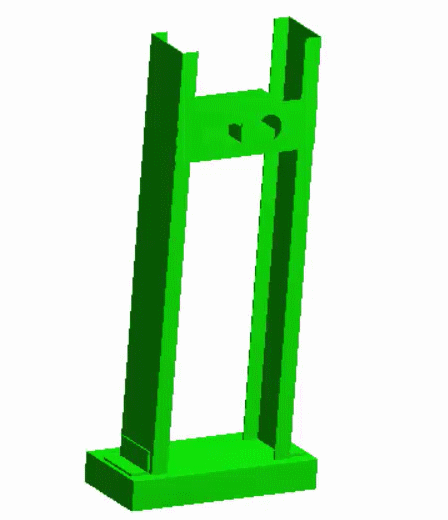 1940 earthquake of El Centro, CA. The student solves the model using the ground motion acceleration time history in a mode superposition transient analysis and then solve the same model using the corresponding response spectrum.
1940 earthquake of El Centro, CA. The student solves the model using the ground motion acceleration time history in a mode superposition transient analysis and then solve the same model using the corresponding response spectrum.
The student confirms that the response spectrum model stresses and displacements match the worst stresses and displacements from the transient model.
Chapter 6 Dynamic Shock Analysis using Dynamic Load Factor
Workshop 6 Analysis of a PWB Assembly Subjected to Half Sine Shock Using Dynamic Load Factor
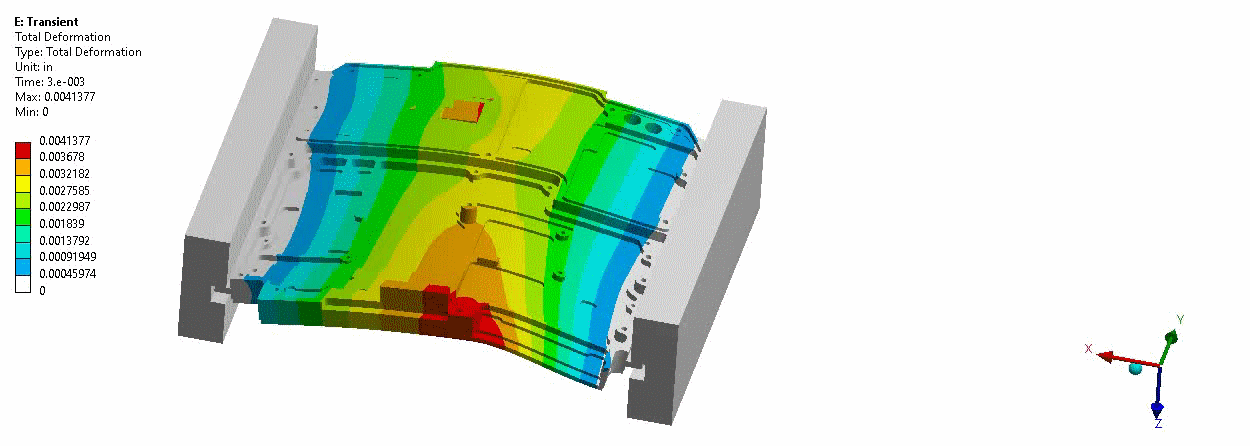
In this workshop the student uses the Dynamic Load Factor approach to solve the problem of a PWB assembly subjected to half sine shock. The DLF approach allows the engineer to avoid performing a transient solution. The DLF method involves doing a normal modes analysis and then finding a factor based on the ratio first mode’s period to the shock pulse time. The student then uses this ratio in a look up table to scale the results of a static model.
Chapter 7 Nonlinear Transient Analysis
Workshop 7a Drop Test Simulation of a Radio Housing Assembly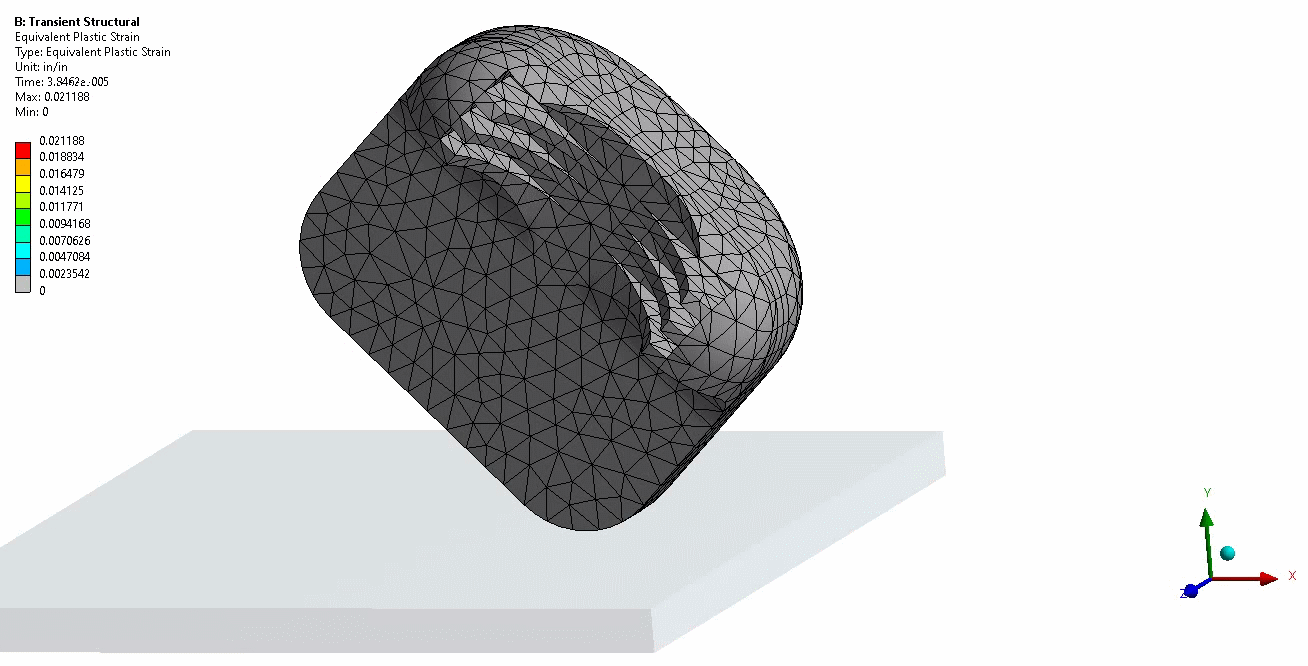
This workshop involves drop test simulation of a plastic radio housing, and it reinforces the skills the student learned in Workshop 7a. A new twist is that the student will set up an initial velocity initial condition for the housing to specify the housing velocity immediately prior to impact. The initial velocity is based on the drop height.
Workshop 7b Nonlinear Transient Dynamic Analysis to Simulation PWB Bench Test
This workshop introduces the student to nonlinear transient dynamic analysis. With this model the student simulates a technician’s accidental drop of a PCB on a workshop table. The model involves solving the model initially as static to set up initial conditions.
Workshop 7c Plucking Technique to Estimate the Natural Frequency of a Propeller Roof Fan Assembly
This workshop demonstrates the technique to calculate natural frequency for a nonlinear system. This fan blade assembly has nonlinear contact, and sheet metal deflections are sufficient large that large deflection effects need to be active.
The technique is a plucking technique. The first step of the solution is to perform a static analysis with imposed nonzero displacements, i.e. the pluck. In step 2 the imposed displacements are removed and dynamic effects are activated so that the structure can vibrate freely as a nonlinear transient dynamic model. The student calculates natural frequency by measuring the time between displacement peaks as the structure vibrates.
Workshop 7d Explicit Dynamic Analysis Simulating an Oblique Projectile Impact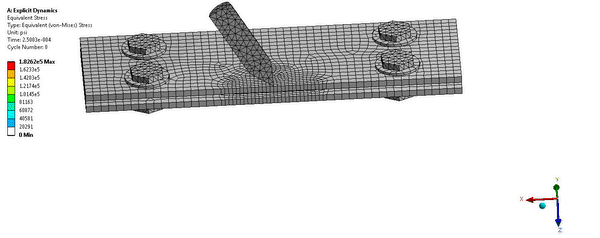
This workshop introduces the student to nonlinear transient dynamics using the Ansys Mechanical explicit dynamics solver. The student defines material failure criteria so that the kinetic energy project is able to make a hole through the two plates during impact.
Workshop 7e Tree Grapple Rigid Body Dynamic and Flexible Nonlinear Transient Dynamic Simulation
This workshop introduces joints and the rigid dynamics solver. The student defines joints for the tree grapple mechanism and checks the system kinematic model number of degrees of freedom using Ansys redundancy analysis. He then runs the solution with all of the parts defined as rigid using the rigid dynamics solver. The rigid dynamics solution allows the engineer to confirm that the joints are defined properly, and it also allows the engineer to check joint forces. Finally, the student makes the boom flexible, solves the model using the flexible body nonlinear transient dynamics solver, and compares the rigid and flexible body solutions.
Workshop 7f Tree Grapple Rigid Dynamic with Component Mode Synthesis Simulation
Workshop 7f is a continuation of workshop 7e. The student returns to the rigid dynamics version of the tree grapple model and employs component mode synthesis (CMS) to the boom of the rigid dynamics model. CMS allows flexible parts in rigid dynamics solutions. Finally the student compares the rigid dynamic with CMS solution to the flexible body nonlinear transient dynamic solution.
Chapter 8 Harmonic Analysis
Workshop 8a Harmonic Response Analysis of an Engine Alternator Bracket
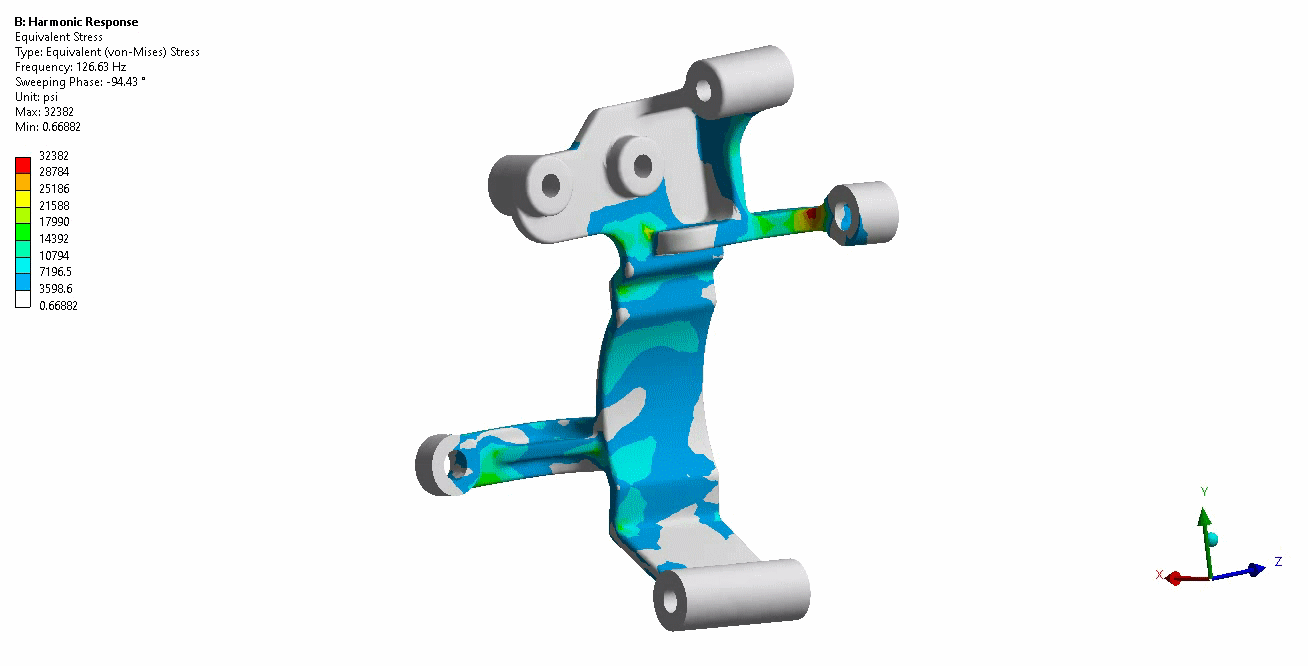
In this workshop we return to the first workshop of the course, the marine engine alternator bracket, in which we calculated natural frequencies and mode shapes. We shake the bracket at its attach points to the engine with harmonic base motion acceleration, and we calculate stresses and fatigue life based on dwelling at the first natural frequency.
Workshop 8b Harmonic Analysis of a Flight Simulator Tilt Base Structure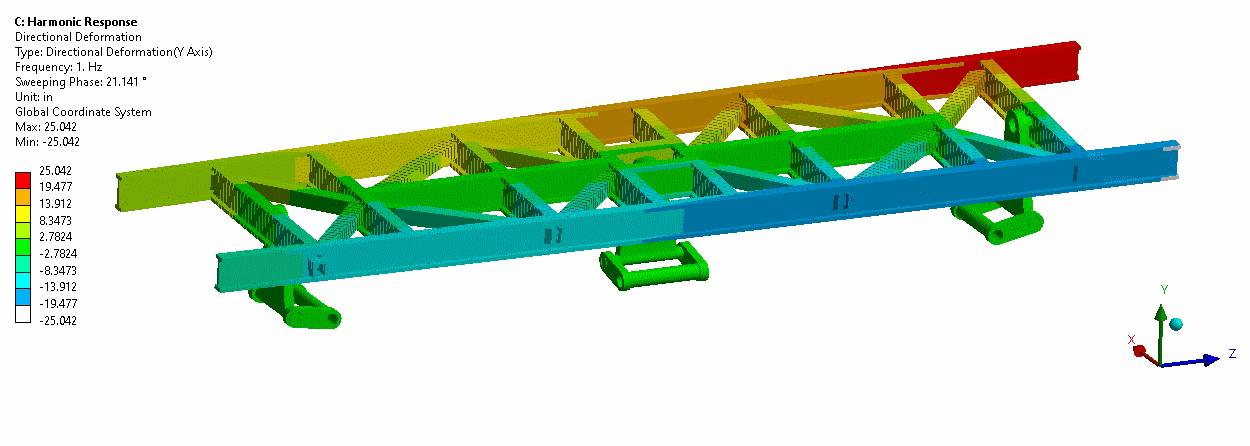
This workshops involves modeling of a fuselage flight trainer tilt base. The structure has scissor mechanisms that allow 3 degrees of freedom in a kinematic sense: vertical motion, pitch, and roll. Three hydraulic cylinders provide motion and can be used to shake the structure to simulate fight turbulence. This workshop allows the student to specify harmonic motion at the hydraulic jacks that are out of phase with one another.
Workshop 8c — Rotating Unbalance Loads on a Steel Structure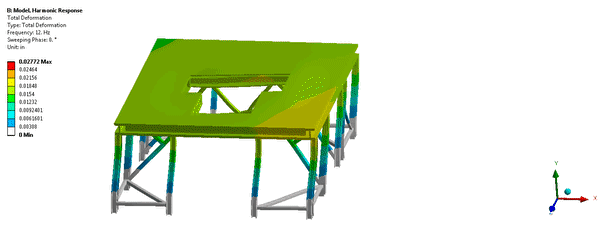
This steel structure has a machine on its deck that has a rotating unbalance load. We use a pair of harmonic loads 90 degrees out of phase with one another to simulate the rotating unbalance load. The model produces displacements and stresses as the structure vibrates due to the rotating unbalance load.



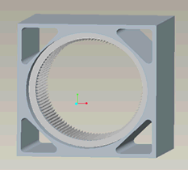




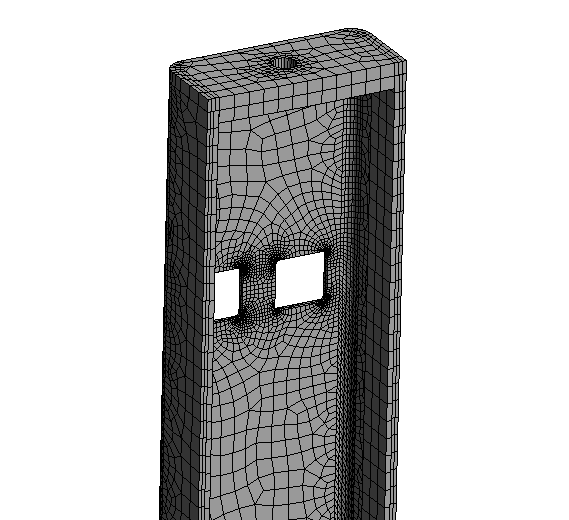
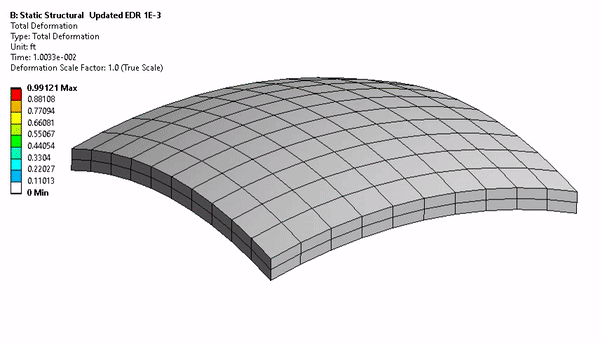
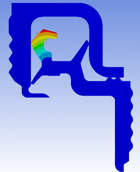

 to be plastically deformed into the seal, which is a hyperelastic body. A pressure is applied to the inside of the tube at a subsequent time. The o-ring undergoes severe deformation; the Nonlinear Adaptive Remeshing technique is used to remesh the model during the solve process automatically to get a completed solution, rather than the user remeshing manually if the model fails to solve.
to be plastically deformed into the seal, which is a hyperelastic body. A pressure is applied to the inside of the tube at a subsequent time. The o-ring undergoes severe deformation; the Nonlinear Adaptive Remeshing technique is used to remesh the model during the solve process automatically to get a completed solution, rather than the user remeshing manually if the model fails to solve.


